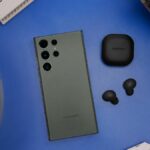
South Korean consumer electronics firm Samsung unveiled its newest 200MP ISOCELL HP3 sensor on June 23. The new sensor is the spiritual successor of the ISOCELL HP1 sensor released in 2021. The new sensor is capable of impressive feats, such as capturing 8K video at 30FPS and better low-light imaging performance than its predecessor. Here are all the details.
Smaller but Better
Samsung’s latest sensor is designed for smartphones. So, efficient use of size is critical. The sensor packs 200 million pixels in a 1/1.4-inch size. The brand claims the new sensor allows for a 20 percent reduction in the surface area required for the camera module. The new sensor also boasts having the industry’s smallest pixels for a mobile sensor, measuring just 0.56 microns each.
Usually, smaller pixels and better low-light performance don’t go in the same sentence. However, things change when you have 200 million pixels. Using the magic of pixel binning, you can combine data from clusters of adjacent pixels on the camera sensor to create individual pixels of the finished image. This technology allows retention of detail and color accuracy while making the final image more petite in size.
Samsung’s new ISOCELL HP3 sensor is also capable of pixel binning. The onboard Tetra2pixel technology can combine data from every set of four adjacent pixels and work like a 1.12 micron 50MP sensor. For even smaller file sizes, the sensor can bin data from 16 pixels to one pixel to deliver images comparable to a 2.24-micron 12.5MP sensor. We hope the mathematics and algorithms translate into usable picture quality, though.
Autofocus and ISO Control
Samsung’s Super QPD technology handles autofocus duties on the ISOCELL HP3. So, all the pixels on the sensor are capable of autofocus. The company explains that Super QPD uses a single lens over every four adjacent pixels to detect phase differences along the horizontal and vertical axes. As a result, autofocus capabilities are improved for the end user.
Additionally, the sensor supports recording video at 8K 30FPS and 4K 120FPS.
The ISOCELL HP3 sensor comes with Samsung’s Smart-ISO Pro mechanism, so HDR images stand out. The sensor offers a unique triple-ISO mode — low, medium, and high — so the final image exhibits a better dynamic range. Samsung claims the new sensor’s 14-bit color depth helps it accurately replicate over 4 trillion colors. The sensor can also switch between Smart ISO Pro and Staggered HDR automatically.
Availability
Samsung says samples of the ISOCELL HP3 sensor have been provided to various smartphone OEMs. The mass production of the sensor will commence later this year. The Galaxy S23 Ultra, expected to launch in 2023, could sport this new camera sensor. Other brands likely to introduce phones with this sensor include Xiaomi and Motorola.
What do you think of the new 200MP ISOCELL HP3 sensor? Is it overkill for a smartphone camera? Tell us in the comments section below.
[Via Samsung]

















